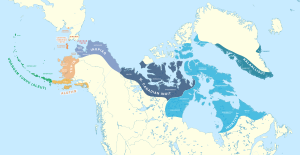ตระกูลภาษาเอสกิโม–อะลิวต์
| ตระกูลภาษาเอสกิโม–อะลิวต์ | |
|---|---|
| เอสกาลิวต์, อินูอิต-ยูปิก-อูนางัค | |
| ภูมิภาค: | อะแลสกา, นอร์ทเวสต์เทร์ริทอรีส์ตอนเหนือ (ภูมิภาคนิคมอินูวิอาลูอิต), นูนาวุต, ควิเบกตอนเหนือ (นูนาวิก), แลบราดอร์ตอนเหนือ (นูนัตซิอาวุต), กรีนแลนด์, รัสเซียตะวันออกไกล (คาบสมุทรชุกชี) |
| การจําแนก ทางภาษาศาสตร์: | หนึ่งในตระกูลภาษาหลักของโลก |
| ภาษาดั้งเดิม: | เอสกิโม–อะลิวต์ดั้งเดิม เอสกิโมดั้งเดิม |
| กลุ่มย่อย: | |
| ISO 639-5: | esx |
| กลอตโตลอก: | eski1264[1] |
 การกระจายตามเขตภูมิศาสตร์ของภาษาตระกูลเอสกิโม–อะลิวต์ | |
ตระกูลภาษาเอสกิโม–อะลิวต์ (อังกฤษ: Eskimo–Aleut languages), ตระกูลภาษาเอสกาลิวต์ (Eskaleut languages) หรือ ตระกูลภาษาอินูอิต-ยูปิก-อูนางัค (Inuit-Yupik-Unangan languages)[2] เป็นตระกูลภาษาพื้นเมืองในอะแลสกา, นูนาวุต, นอร์ทเวสต์เทร์ริทอรีส์ตอนเหนือ (ภูมิภาคนิคมอินูวิอาลูอิต), ควิเบกตอนเหนือ (นูนาวิก), แลบราดอร์ตอนเหนือ (นูนัตซิอาวุต), กรีนแลนด์ และรัสเซียตะวันออกไกล (คาบสมุทรชุกชี)
ตระกูลภาษาเอสกิโม–อะลิวต์แบ่งออกเป็นสองสาขา ได้แก่ สาขาเอสกิโมและสาขาอะลิวต์ สาขาอะลิวต์มีเพียงภาษาเดียวคือภาษาอะลิวต์ ใช้พูดในหมู่เกาะอะลูเชียนและหมู่เกาะพริบิลอฟ และแบ่งออกเป็นหลายภาษาถิ่น ส่วนสาขาเอสกิโมแบ่งออกเป็นสองสาขา ได้แก่ สาขายูปิกซึ่งพูดในอะแลสกาตะวันตกและตะวันตกเฉียงใต้และในคาบสมุทรชุกชี และสาขาอินูอิตซึ่งพูดในอะแลสกาเหนือ แคนาดา และกรีนแลนด์ และประกอบด้วยหลายวิธภาษา วิธภาษาที่อยู่ใกล้กันจะมีความคล้ายคลึงกัน ส่วนวิธภาษาในหมู่เกาะไดออมีดและกรีนแลนด์ตะวันออกซึ่งอยู่ในระยะไกลที่สุดจากศูนย์กลางจะมีความแตกต่างกันมาก[3]
การพิจารณาตำแหน่งที่เหมาะสมของภาษาซีเรนีกีในสาขาเอสกิโมยังไม่เป็นที่ยุติ นักภาษาศาสตร์บางคนถือว่าภาษานี้เป็นสาขาหนึ่งของสาขายูปิก[4] ในขณะที่นักภาษาศาสตร์คนอื่น ๆ ถือว่าเป็นสาขาต่างหากในสาขาเอสกิโมร่วมกับสาขายูปิกและสาขาอินูอิต[5]
อ้างอิง
[แก้]- ↑ Nordhoff, Sebastian; Hammarström, Harald; Forkel, Robert; Haspelmath, Martin, บ.ก. (2013). "Eskimo–Aleut". Glottolog 2.2. Leipzig: Max Planck Institute for Evolutionary Anthropology.
- ↑ "Due to the pejorative nature of the term 'Eskimo' in some locales, and the increasing preference for 'Unangan' as opposed to 'Aleut' in Alaska, this family may be alternately referred to as Inuit-Yupik-Unangan. The hyphenated term gives some sense of the variety of languages subsumed under this family label." Holton, Gary. 2012. Overview of Comparative Inuit-Yupik-Unangan. สืบค้นเมื่อ 18 พฤศจิกายน 2013.
- ↑ Kaplan, Lawrence (1984). McGary, Jane (บ.ก.). Inupiaq and the Schools - A Handbook for Teachers. Alaska Native Language Center, University of Alaska Fairbanks.
- ↑ "Ethnologue report for Yupik Sirenk", Ethnologue, Retrieved 2008-08-25.
- ↑ "Alaska Native Languages – An Overview" เก็บถาวร 9 พฤษภาคม 2008 ที่ เวย์แบ็กแมชชีน. สืบค้นเมื่อ 25 สิงหาคม 2008.
Text is available under the CC BY-SA 4.0 license; additional terms may apply.
Images, videos and audio are available under their respective licenses.
